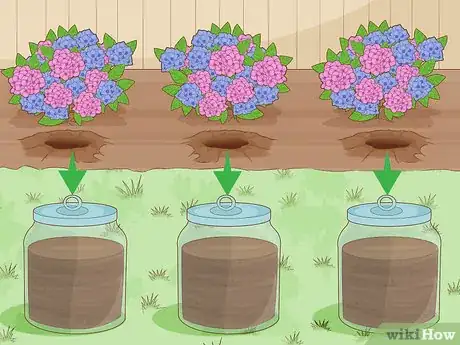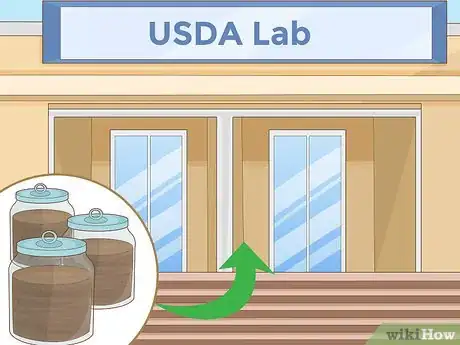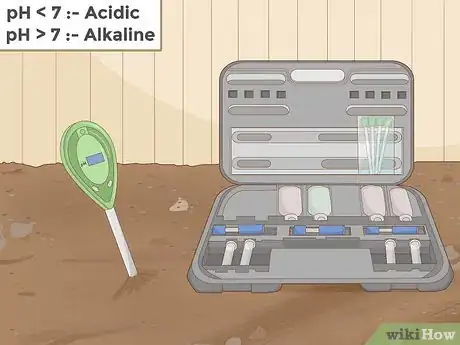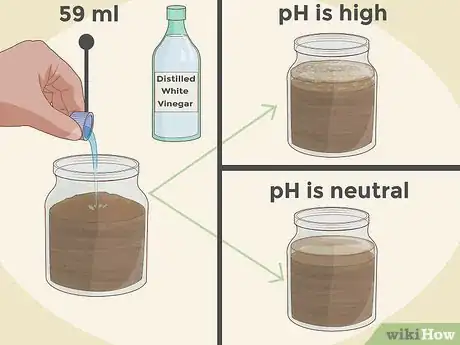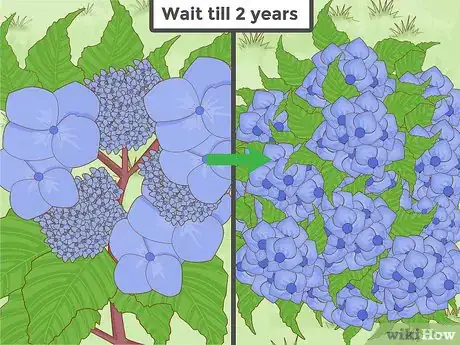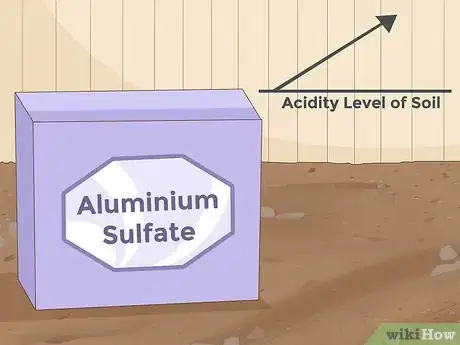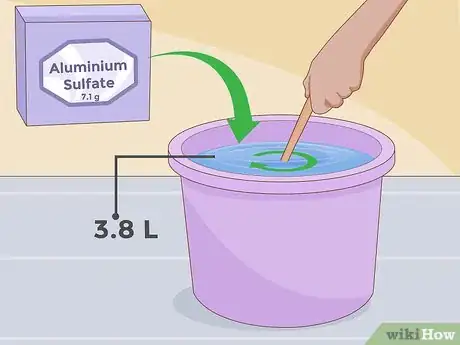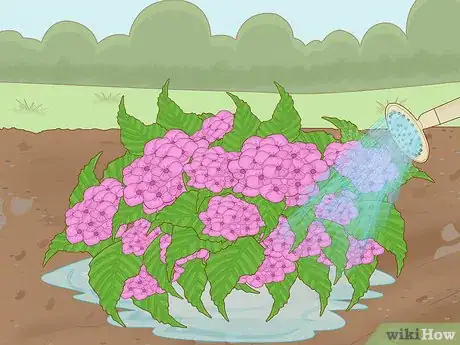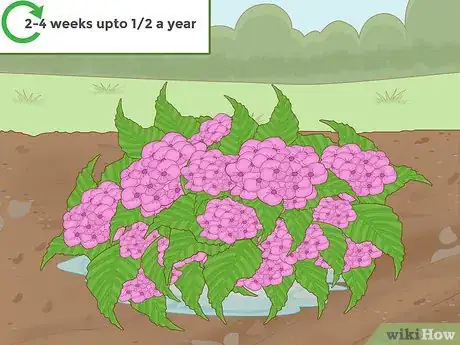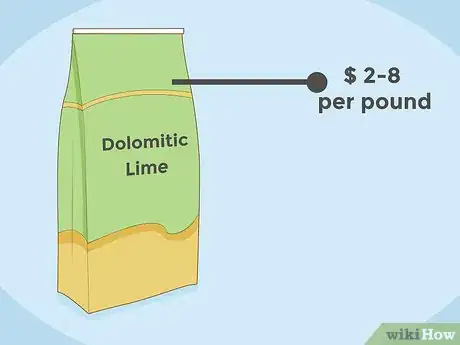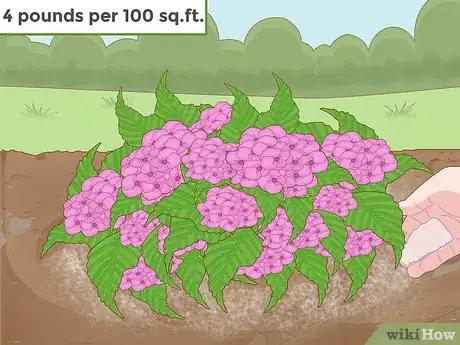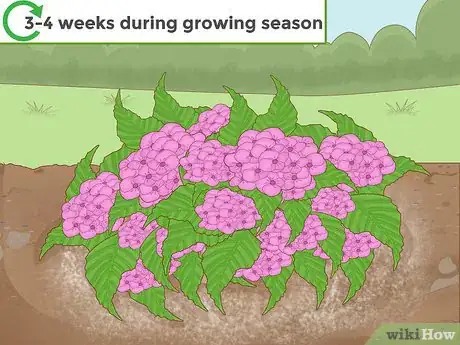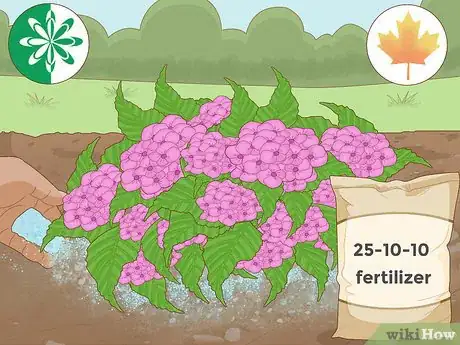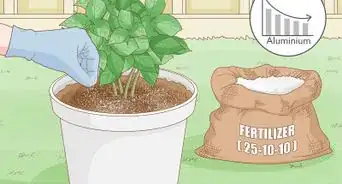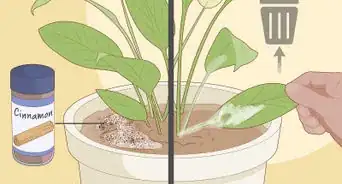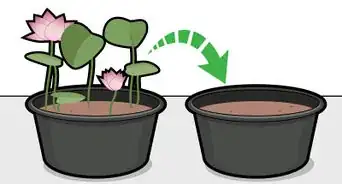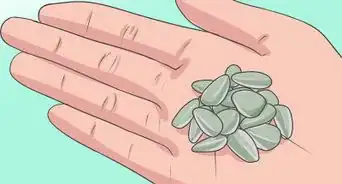This article was co-authored by wikiHow Staff. Our trained team of editors and researchers validate articles for accuracy and comprehensiveness. wikiHow's Content Management Team carefully monitors the work from our editorial staff to ensure that each article is backed by trusted research and meets our high quality standards.
There are 11 references cited in this article, which can be found at the bottom of the page.
wikiHow marks an article as reader-approved once it receives enough positive feedback. In this case, 94% of readers who voted found the article helpful, earning it our reader-approved status.
This article has been viewed 96,795 times.
Learn more...
Hydrangeas are prized for their vibrant blooms. What you might not know is that it’s possible to change the color of pink and blue varieties of hydrangeas by simply altering the pH level of your growing soil. Use diluted aluminum sulfate to increase the acidity of the soil and turn pink flowers a lustrous, silvery blue. If you want to transform your hydrangeas from blue to pink, spread limestone over the soil to lower the acidity and watch them begin to blush!
Steps
Testing Your Soil’s pH
-
1Collect a sample of the soil your hydrangeas are planted in. Head out to your garden and use a hand trowel to dig 4-5 small holes to a depth of 6–8 inches (15–20 cm) each in the area around your hydrangea. Then, scrape a 1⁄2 inch (1.3 cm) layer of soil from the side of each hole. Combine your samples in a large container and seal the container to keep the soil fresh.[1]
- Plastic and glass containers work best for storing soil samples. These materials are free of chemicals that might leech into your sample and throw off its composition.[2]
- If you have multiple hydrangeas spread throughout your garden, it's a good idea to take a sample from each individual area, as soil composition can vary quite a bit in just a few feet.
Tip: Mixing together multiple samples from different spots around the plant will help you determine the “average” acidity of your growing soil.
-
2Send your soil sample to your local USDA co-op lab for testing. Double-check that your collection container is properly sealed and place it inside an airtight plastic bag. If you live in the United States, run a search for the USDA co-op research and extension office closest to your area and ship your sample off for detailed analysis. The results they send back will tell you everything that’s in your soil.[3]
- In some cases, your local extension office may charge a small fee for running soil examinations.
- Certain plant nurseries and gardening centers may also be equipped to perform soil tests.
Advertisement -
3Test your soil's pH yourself with a commercial soil testing kit. To use your test kit, burrow a hole in the middle of your soil sample and fill it with distilled water. Then, insert the included test probe or strip into the muddy water and wait for the amount of time specified in the instructions. At the end of this time, read the number on the probe or compare the color of the strip to the chart on the product's packaging to determine the pH level of your soil.[4]
- If you see a number lower than 7, it means your soil is acidic. If it's higher than 7, it's basic, or alkaline. A reading of exactly 7 means that your soil has a neutral pH.[5]
- You can purchase a soil testing kit at any gardening store or home improvement center. Many of these kits contain enough probes or strips for multiple tests.
- It's important that you use distilled water when testing your soil at home. Since it has a neutral pH, you won't have to worry about it throwing off your results.
-
4Run a quick DIY pH test using vinegar. If you don’t feel like going to the trouble of sending off for a detailed soil analysis or using a home testing kit, there’s a clever trick you can try right away in your own kitchen. Uncover your collection container and pour 1–2 fluid ounces (30–59 mL) of distilled white vinegar over the soil. If the vinegar fizzes when it touches the soil, it means that the soil’s pH is especially high.[6]
- If your soil has an acidic or neutral pH, the vinegar won’t react in any way.
- This test is only useful for identifying highly alkaline soil, and won’t tell you anything about its exact pH levels.
-
5Wait until your hydrangeas are hearty before experimenting with them. Hold off on attempting to change the color of your hydrangeas until they’re at least 2 years old. This will give them a chance to recover from the initial shock of planting and balance out their own natural chemicals.[7]
- Generally speaking, it’s not a good idea to mess too much with your soil's pH. Be aware that attempting to change the color of your hydrangeas could impact their health, even if they're well-established.
Turning Pink Hydrangeas Blue
-
1Purchase a package of aluminum sulfate. This naturally-occurring salt can be used to safely bump up the acidity level of basic soil. Aluminum sulfate is available at most gardening supply stores, as well as the lawn and garden section of various supercenters. A 4 lb (1,800 g) box will usually only run you around $12-15.[8]
- If you don’t want to spend money on pure aluminum sulfate, another option is to start saving your old coffee grounds, egg shells, and citrus peels in a covered container. When allowed to decompose for 2-3 days, these materials will release compounds that can drive up soil pH.
-
2Mix 1⁄4 ounce (7.1 g) of aluminum sulfate with 1 gallon (3.8 L) of water. Measure out the salt in the bottom of a watering can, then pour in the water. Stir or shake the mixture until the salt dissolves completely.[9]
- These amounts should only serve as a rough guideline. Always follow the manufacturer’s instructions outlined on the label of the specific product you’re working with to ensure that you’re using a safe concentration.
-
3Apply the aluminum sulfate solution liberally to your growing soil. Treat the application as though you were performing a routine watering—soak the soil around the base of the plant thoroughly, stopping when the liquid just begins to pool. Do this for each hydrangea you want to treat.[10]
- There’s no need to wet the leaves or flowers themselves. The plant will take in the diluted aluminum sulfate through its roots and spread it outward to the foliage.
- If you’ve decided to use coffee grounds, egg shells, citrus peels, or other organic materials, simply work them below the surface of the soil and water the plant as usual afterwards.[11]
Warning: Avoid overwatering your hydrangeas. Too much water is already bad for plants, and the addition of aluminum sulfate will only make it more harmful.
-
4Continue treating your hydrangeas every 2-4 weeks for up to half a year. The change of color won’t happen right away. In fact, It may take weeks or even months before you begin to notice a difference. Keep up with your aluminum sulfate applications throughout the spring and summer, then scale it back in the fall and winter when the plant goes dormant.[12]
- Ideally, the pH level of your growing soil should remain between 5.2 and 5.5 consistently.
- Introducing aluminum sulfate to your hydrangeas once they've entered dormancy could stunt their return in the spring or even cause them to die off. Monitor your plants closely and discontinue your applications if they appear to be in poor health.
- The species you're working with, as well as the specific conditions of your growing soil, may have an impact on the final coloration of your hydrangeas. Flowers with a deep pink or reddish cast, for example, may take on a hue that’s more purple than delicate blue.[13]
Making Blue Flowers Pink
-
1Pick up a bag of ground gardening lime. This type of lime is also sometimes known as “dolomitic lime.” You’ll find it at any gardening center, along with hardware stores and online retailers. Depending on where you get your lime, and how much you buy, it may cost $2-8 per 1 pound (450 g).[14]
- Gardening lime comes in bags ranging in sizes from 1–50 pounds (450–22,680 g). You’ll be using it to condition your hydrangeas regularly for up to 6 months at a time, so make sure you buy enough.
- Lime is highly alkaline, which means it serves to raise the pH of your planting soil, causing pale blue hydrangeas to become a rosy pink in the process.[15]
-
2Spread the lime evenly over the soil at the base of your plants. Transfer the granulated lime to a garden spreader, or simply sprinkle it on using a measuring cup or gloved hand. Gardening experts recommend applying a ratio of 4 pounds (1,800 g) per 100 square feet (9.3 m2) to avoid overloading the soil.[16]
- You can apply lime immediately before or between your regular waterings. All that matters is that it makes direct contact with the soil.
- Be careful not to heap on too much lime at one time. Doing so will infuse your soil with huge quantities of magnesium, resulting in sickly, discolored leaves or, worse, dead hydrangeas.[17]
Tip: For best results, aim to keep the pH of your growing soil between 6.0 and 6.2. Testing your soil regularly will help you stay within the optimal range.
-
3Reapply the lime every 3-4 weeks during the growing season. Continue conditioning your hydrangeas throughout the spring and summer months while they’re still actively growing. You should begin to witness a gradual change in color after several weeks or months. When you do, the effects will be quite stunning.[18]
- Remember not to apply lime more than once in any 3-4 week interval.
- You’ll usually get more pronounced and immediate results turning blue hydrangeas pink than you will turning pink ones blue.[19]
- If you fail to keep up with your lime applications, your hydrangeas may revert to their original color as the chemical levels of the surrounding soil return to normal. You can resume your applications at the beginning of the following growing season.
-
4Feed your hydrangeas with a 25-10-10 fertilizer in late spring or fall. At the end of the growing season, apply a layer of phosphorus-rich fertilizer to all of your plants. Be sure to distribute the fertilizer according to the manufacturer's instruction for your climate and soil type. When you’re done, wait until the following spring to resume your regular lime applications, if desired.[20]
- It’s important to use a fertilizer that contains high levels of phosphorus in order to prevent aluminum (which turns pink flowers blue) from creeping into the soil.[21]
- Fertilization will restore vital nutrients to your growing soil and prevent the added magnesium in the lime from harming your hydrangeas.
Community Q&A
-
QuestionMy snowball hydrangea looks awful due to the continued drought. If I cut it back will it help for next year? When is the best time to cut it back?
 Community AnswerYou should cut the flowers off after every flowering at the end of the season.
Community AnswerYou should cut the flowers off after every flowering at the end of the season. -
QuestionIf my red hydrangea plant grew a dark pink flower, how can I get a red flower back?
 Community AnswerThe pink flower may be an anomoly. Your plant will most likely flower red again.
Community AnswerThe pink flower may be an anomoly. Your plant will most likely flower red again. -
QuestionHow can I make a white hydrangea stay really white?
 Community AnswerEnsure that the soil pH is between 6.0 and 6.2, and test it both before and after adding a slow release, 10-10-10 fertilizer. Don't over-water the plant. Ensure that it is in dappled to full shade.
Community AnswerEnsure that the soil pH is between 6.0 and 6.2, and test it both before and after adding a slow release, 10-10-10 fertilizer. Don't over-water the plant. Ensure that it is in dappled to full shade.
Warnings
- Keep in mind that by introducing foreign substances to your growing soil in an effort to recolor your hydrangeas, you’ll be interfering with their natural conditions. This could potentially weaken or even kill your plants.⧼thumbs_response⧽
- Unfortunately, it’s not possible to change the color of white hydrangeas, no matter how hard you try.[22]⧼thumbs_response⧽
Things You’ll Need
Testing Your Soil’s pH
- Hand trowel
- Lidded plastic or glass container
- Airtight plastic bag
- Commercial soil testing kit (optional)
- Distilled white vinegar (optional)
Turning Pink Hydrangeas Blue
- Pure aluminum sulfate
- Watering can
- Water
- Coffee grounds, egg shells, citrus peels, or other organic materials (optional)
Making Blue Flowers Pink
- Gardening lime (dolomitic lime)
- Garden spreader or measuring cup
- Water
- 25-10-10 fertilizer
References
- ↑ https://www.lowes.com/projects/lawn-and-garden/test-and-improve-your-soil/project
- ↑ https://www.nrcs.usda.gov/Internet/FSE_DOCUMENTS/nrcs142p2_037208.pdf
- ↑ https://www.nrcs.usda.gov/Internet/FSE_DOCUMENTS/nrcs142p2_037208.pdf
- ↑ https://www.bobvila.com/articles/how-to-test-soil-ph/
- ↑ https://www.finegardening.com/article/the-four-things-you-need-to-know-about-soil-ph
- ↑ https://www.gardenista.com/posts/magic-trick-how-to-make-your-hydrangea-change-color/
- ↑ https://www.almanac.com/content/how-change-color-hydrangeas#
- ↑ https://www.gardenista.com/posts/magic-trick-how-to-make-your-hydrangea-change-color/
- ↑ https://www.almanac.com/content/how-change-color-hydrangeas#
- ↑ https://www.almanac.com/content/how-change-color-hydrangeas#
- ↑ https://www.gardenista.com/posts/magic-trick-how-to-make-your-hydrangea-change-color/
- ↑ https://gardentherapy.ca/hydrangea-change-color/
- ↑ https://www.southernliving.com/home-garden/gardens/hydrangea-color
- ↑ https://www.almanac.com/content/how-change-color-hydrangeas#
- ↑ https://www.canr.msu.edu/news/should_i_use_dolomitic_or_calcitic_lime
- ↑ https://www.almanac.com/content/how-change-color-hydrangeas#
- ↑ https://www.smilinggardener.com/organic-soil-management/dolomite-lime/
- ↑ https://gardentherapy.ca/hydrangea-change-color/
- ↑ https://www.almanac.com/content/how-change-color-hydrangeas#
- ↑ https://www.almanac.com/content/how-change-color-hydrangeas#
- ↑ https://www.growingagreenerworld.com/the-numbers-on-fertilizer-labels-what-they-mean/
- ↑ https://gardentherapy.ca/hydrangea-change-color/
